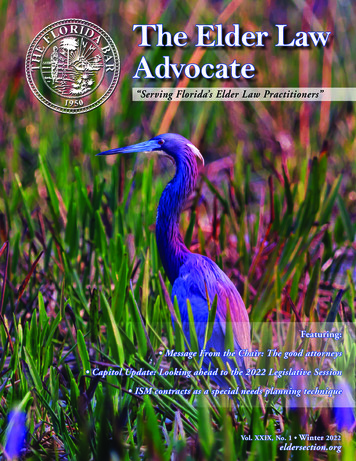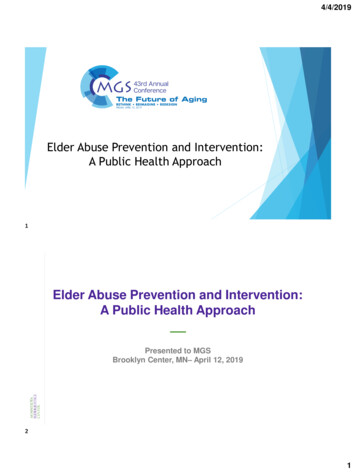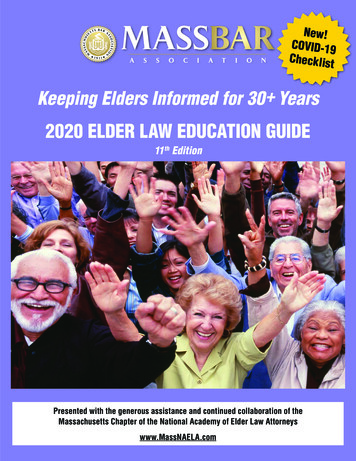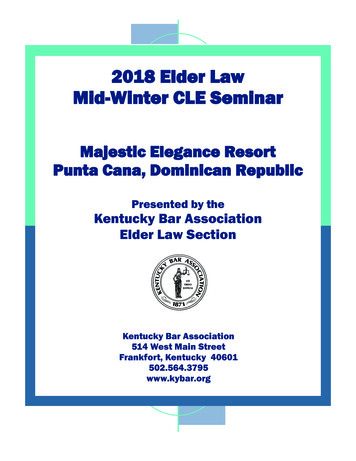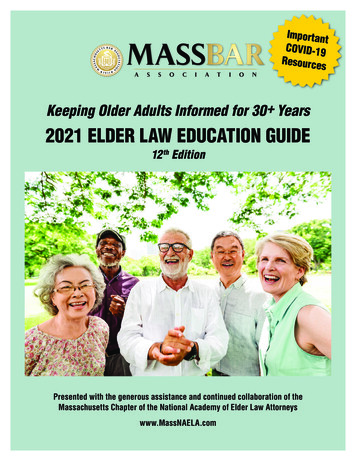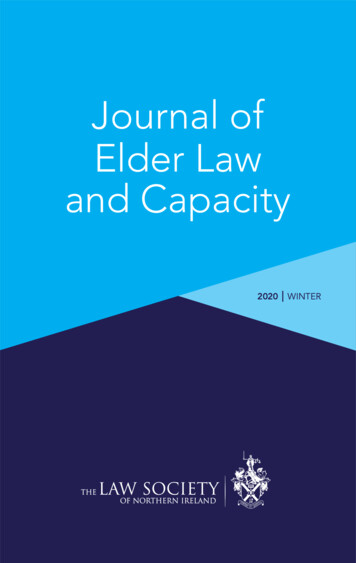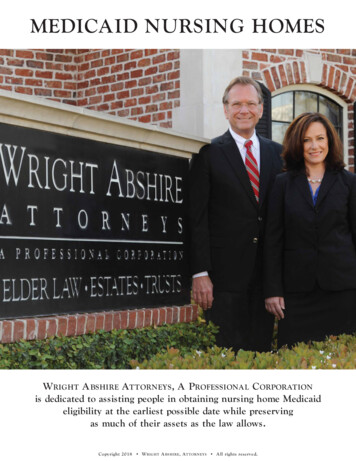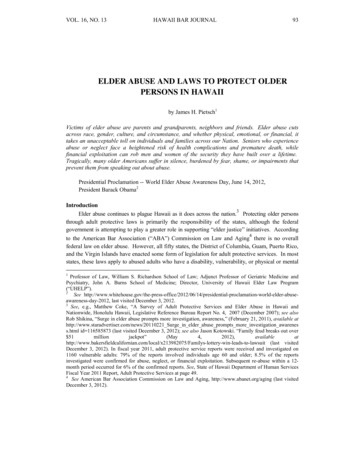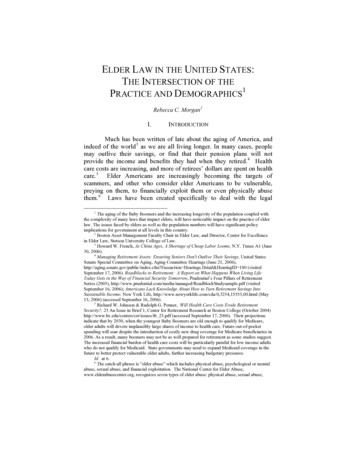
Transcription
ELDER LAW IN THE UNITED STATES:THE INTERSECTION OF THEPRACTICE AND DEMOGRAPHICS1Rebecca C. Morgan 2I.INTRODUCTIONMuch has been written of late about the aging of America, andindeed of the world 3 as we are all living longer. In many cases, peoplemay outlive their savings, or find that their pension plans will notprovide the income and benefits they had when they retired.4 Healthcare costs are increasing, and more of retirees’ dollars are spent on healthcare. 5 Elder Americans are increasingly becoming the targets ofscammers, and other who consider elder Americans to be vulnerable,preying on them, to financially exploit them or even physically abusethem. 6 Laws have been created specifically to deal with the legal1The aging of the Baby Boomers and the increasing longevity of the population coupled withthe complexity of many laws that impact elders, will have noticeable impact on the practice of elderlaw. The issues faced by elders as well as the population numbers will have significant policyimplications for government at all levels in this country.2Boston Asset Management Faculty Chair in Elder Law, and Director, Center for Excellencein Elder Law, Stetson University College of Law.3Howard W. French, As China Ages, A Shortage of Cheap Labor Looms, N.Y. Times A1 (June30, 2006).4Managing Retirement Assets: Ensuring Seniors Don't Outlive Their Savings, United StatesSenate Special Committee on Aging, Aging Committee Hearings (June 21, eaction Hearings.Detail&HearingID 180 (visitedSeptember 17, 2006). Roadblocks to Retirement: A Report on What Happens When Living LifeToday Gets in the Way of Financial Security Tomorrow, Prudential’s Four Pillars of RetirementSeries (2005), tudysample.pdf (visitedSeptember 16, 2006); Americans Lack Knowledge About How to Turn Retirement Savings IntoSustainable Income, New York Life, l (May15, 2006) (accessed September 16, 2006).5Richard W. Johnson & Rudolph G. Penner, Will Health Care Costs Erode RetirementSecurity?, 23 An Issue in Brief 1, Center for Retirement Research at Boston College (October 2004)http://www.bc.edu/centers/crr/issues/ib 23.pdf (accessed September 17, 2006). Their projectionsindicate that by 2030, when the youngest Baby Boomers are old enough to qualify for Medicare,older adults will devote implausibly large shares of income to health care. Future out-of-pocketspending will soar despite the introduction of costly new drug coverage for Medicare beneficiaries in2006. As a result, many boomers may not be as well prepared for retirement as some studies suggest.The increased financial burden of health care costs will be particularly painful for low income adultswho do not qualify for Medicaid. State governments may need to expand Medicaid coverage in thefuture to better protect vulnerable older adults, further increasing budgetary pressures.Id. at 6.6The catch-all phrase is “elder abuse” which includes physical abuse, psychological or mentalabuse, sexual abuse, and financial exploitation. The National Center for Elder Abuse,www.elderabusecenter.org, recognizes seven types of elder abuse: physical abuse, sexual abuse,
2007]Elder Law in the United States104problems faced by older Americans. 7 There is a label for this area oflaw–elder law. Elder law has grown from a speciality practice to ageneral area of practice within which an attorney may specialize.This article will look at the demographics of America now and inthe near future. It will examine the creation and growth of the elder lawpractice in the U.S. Specific laws pertaining to elder law will bereviewed. The article will conclude by examining the near future andcoming developments in elder law in the United States.II. THE AGING OF AMERICAWho are these people anyway? The United States is not alone inthis aging of its population, and other countries, including Italy, the U.K.,Sweden, Japan, and Germany have high percentages of elders. 8Boomers are expected to be better educated than seniors of the past, and,as a result, are expected to be more demanding, especially for healthcare. 9 Demographic data has been predicting a significant growth in the65 and over population as the Boomers 10 hit retirement age. By 2030,twenty percent of the population will be sixty-five or older. 11The yet-unanswered question for all elders, current and future, iswhether the increased life expectancy for U.S. citizens will be “good” orwhether the elders will suffer from chronic and disabling conditions. 12Although it is clear that there is a correlation between age and chronichealth conditions, 13 generally it seems that people not only are livingemotional or psychological abuse, neglect, abandonment, financial or material exploitation, and selfneglect. See http://www.elderabusecenter.org/default.cfm?p basics.cfm (accessed July 1, 2006).7Generally speaking, many of the laws are age-neutral. For example, guardianship orconservatorship statutes apply to every person who meets the statutory definition of incapacity. Thelaws governing nursing homes’ residents apply to those who reside in nursing homes regardless ofage. On the other hand, there are age-specific laws. For example, some laws governing elder abuseare applied to victims of a certain age and vulnerability. Medicare and Social Security laws aremainly age-based, but also include other covered groups such as spouses or dependents, orindividuals with disabilities.8Id.9Id.10Baby Boomer refers to the generation born during a particular span of years. MerriamWebster OnLine defines baby boom as “a marked rise in birthrate (as in the United Statesimmediately following the end of World Ward II) ed Mar. 22, 2007). Baby Boomers in the United States are generally considered as thatgeneration of Americans born between 1946 and 1964. See chives/facts for features special editions/006105.html.11AGS Aging in the Know, Trends in the Elderly know/chapters ch trial.asp?ch ugh the number of elders with disabilities is declining, at least eighty percent of eldershave at least one chronic health condition, and fifty percent have two. HHS & U.S. Department ofCommerce, 65 In The United States: 2005, http://www.census.gov/prod/2006pubs/p23-209.pdf, at
105The Journal of International Aging, Law & Policy[Vol. IIlonger, but are living healthier lives. 14 Will the extra years be goodyears? Studies seem to suggest yes. 15Bottom line—there are significant numbers of elders in the U. S.and elsewhere and more are coming. Beyond that, the population can bebroken down by sex, age, race, income, education, and more. 16 Thesheer numbers will affect this country as never before—in the workforce, in the provision of health care, in the economy, and in determiningsocial policy.III.ELDER LAW IN THE UNITED STATES–FROM A NICHE TO AGENERAL PRACTICE AREAElder law is the representation of elder Americans and theirfamily members with legal problems. According to the NationalAcademy of Elder Law Attorneys (“NAELA”), 17 elder law is defined bythe client:Rather than being defined by technical legal distinctions,elder law is defined by the client to be served. In otherwords, the lawyer who practices elder law may handle arange of issues but has a specific type of clients--seniors.58-63. (December 2005). This generalization may not hold true when the statistics for assistancewith activities of daily living (ADL) are examined. See id. at 60.14Id. at 1.15There is a debate among the experts on how old we can live to be and what quality of life wewill have during those extra years. Id. at 50 (citing to Manton and Gu, 2001; Freedman et al., 2002;Spillman and Lubitz, 2000). There is the possibility that people will live longer but with functionaland cognitive impairments. Id.One way to determine qualify of life is to use the “Active Life Expectancy” “ to measurethe number of years that people can expect to live on average without disability.” Recent studies,from a variety of methods of analysis and measurement, show “that in addition to living longer, thecurrent generation of older people are healthier and less disabled” when compared to theirpredecessors. Id. at 50 (citing to Manton et al., 1997; Freedman, 1998; Manton and Gu, 2001;Freedman et al., 2002).16Id.17The National Academy of Elder Law Attorneys (NAELA) is a membership organization ofattorneys who practice elder law. According to the NAELA website, NAELA is aprofessional association of attorneys who are dedicated to improving the quality of legalservices provided to the elderly.The primary focus of the Academy is education. The Academy sponsors continuing legaleducation programs on elder law for attorneys throughout the year, and provides publications andeducational materials to its members on a wide range of elder law topics.The Academy seeks to provide support to other organizations serving the elderly. NAELA alsoexamines and advocates on public policy issues facing the elderly, but does not provide direct legalservices.See http://www.naela.com/public/whatisneala.htm (accessed July 1, 2006).
2007]Elder Law in the United States106Elder law attorneys focus on the legal needs of theelderly, and work with a variety of legal tools andtechniques to meet the goals and objectives of the olderclient.Under this holistic approach, the elder law practitionerhandles general estate planning issues and counselsclients about planning for incapacity with alternativedecision making documents. The attorney would alsoassist the client in planning for possible long-term careneeds, including nursing home care. Locating theappropriate type of care, coordinating private and publicresources to finance the cost of care, and working toensure the client's right to quality care are all part of theelder law practice. 18Elder law has now been a recognized practice area for almostthirty-five years, 19 although for private practitioners most of the growthhas occurred in the past twenty years. Initially, “aging and the law” wasthe province of legal services attorneys, while private practitioners werepracticing “traditional” estate planning. 20 Professor Larry Frolik 21 tookthe view that elder law came into being because of attorneys’ interest inthe area and the interest of academics in the field. 22 As noted by18Id.The National Senior Citizens Law Center (NSCLC) was established in 1972. NSCLC“advocates nationwide to promote the independence and well-being of low-income elderlyindividuals and persons with disabilities.” .The National Senior Citizens Law Center was created in 1972 when, Terry Hatter, thenDirector of the Western Center on Law and Poverty in Los Angeles and now a 12-year veteran of thefederal district court, submitted an application to the Office of Economic Opportunity to create anation(sic) “back-up center” for issues affecting the elderly poor.See http://www.nsclc.org/about nsclc.html; see also Gill DeFord, Twenty Years of theNational Senior Citizens Law Center: A Personal Recollection 26 Clearinghouse Review 117(Special Issue, 1992).20Michael Gilfix, Esq., one of the founders of NAELA, started his career in elder law byfounding the Senior Adults Legal Assistance (SALA), a legal aid program for seniors in Santa ClaraCounty, California. On entering private practice with his wife, he “identified other attorneys acrossthe nation with similar interests. . . .” including legal aid attorneys, estate planners, and “some . . .interested in the idea, and some . . . motivated exclusively by the profit motive.” Michael Gilfix,Creation And Evolution of Elder Law, 12 NAELA Q. 7 (Winter 1999).21Professor Frolik is a Professor of Law at the University of Pittsburgh School of Law.Considered one of the founders in the field of elder law, Professor Frolik is a prolific writer who hasauthored several treatises and a number of articles on subjects of elder law. Professor Frolik haswritten two articles tracing the development of the practice of elder law. Professor Frolik could beconsidered one of the Deans of elder law.22“Elder law owes its existence to the convergence of two social and intellectual forces: thedesire of lawyers to create legal practices which have come to be called elder law, and thesimultaneous growth of academic interest in the topic of the elderly and the law”, noting that “[t]he19
107The Journal of International Aging, Law & Policy[Vol. IIProfessor Frolik, the field of practice would exist even without the label“elder law.” 23It took a while for the public to grasp the concept of elder law, infact, comments were frequently made about the name of the practicearea. 24 However, one thing that distinguished elder law from other areasof practice is the holistic nature of elder law. Although the practice arealabel tends to come from the tasks performed by lawyers, 25 elder law hascome to be recognized not only by the legal tasks performed by thelawyers, but by the attorney’s function as a counselor to the client and/orthe client’s family, the attorney’s knowledge of the aging servicesnetwork and the nature of the representation of the clients in the lateryears of their lives. 26Twenty-plus years later, an exact definition of elder law stilltends to depend on whom one asks. 27 Elder law has evolved from arise of elder law obviously is also depending upon the growth in the number and relative wealth ofthe elderly. . . . [Professor Frolik’s] purpose [was] to consider the other, less obvious factors, thathelp explain the growth of elder law. . . . Lawrence A. Frolik, The Developing Field of Elder Law: AHistorical Perspective, 1 Elder Law J. 1 (Spring 1993).23Lawrence A. Frolik, The Developing Field of Elder Law: A Historical Perspective, 1 ElderL. J. 1, 1-2 (Spring 1993). “Of course, elder law would exist even if not identified as such . . . [e]lderlaw exists whether or not it has a label. Id.24Perhaps the confusion stemmed from the title “elder law” which, although descriptive, is atthe same time ambiguous. The author would frequently hear remarks such as “elder law, that’s lawfor old attorneys” or “you’re too young to be practicing elder law.”Professor Frolik relates a conversation he had with an attorney who asked him aboutelder law, and when he described it, the attorney responded “[t]hat’s what I do. I guess that I’ve beenan elder attorney for years and never knew it.” Lawrence A. Frolik, The Developing Field of ElderLaw: A Historical Perspective, 1 Elder L. J. 1, n. 2 (Spring 1993). See also Lawrence A. Frolik, TheDeveloping Field of Elder Law Redux: Ten Years After, 10 Elder L. J. 1 (2002) (noting ten yearslater that attorneys have at least heard of elder law, even if they don’t have a good idea of what itinvolves).Now elder law is a recognized practice area, but is not completely descriptive of thepractice. In fact NAELA recently changed its tag line to include clients with special needs,recognizing that oftentimes elder law attorneys also represent clients with disabilities who do not fallinto the category of elder. See www.naela.com.25The Developing Field of Elder Law, supra n. 24, at 2.26Professor Frolik focuses more on the legal tasks, noting that “. . . the term elder law bundlestogether a variety of legal work. The term, however, does not only aggregate a group of existingactivities. It implies something more, a new kind of legal practice, a new way to perceive what thelawyer does. The term elder law is both a collective title for existing activity and a new category oflegal work which creates new practice possibilities for lawyers.” The Developing Field of ElderLaw, supra n. 24, at 2.27For example, Stu Zimring, a past president, fellow and member of CAP of NAELA describeshis view of elder law as:a broad, very holistic, communitarian approach, defining it in terms of assisting seniors andtheir families, primarily in helping them age in place whenever possible. I do not and have neverrestricted the definition to “public benefit planning”. For those who do, the answer is ElderLaw/public benefit planning is probably doomed since the opportunities to do this kind of planningwill become increasingly difficult or (I should live so long) there will be a national healthcare systemin place that makes such planning unnecessary. For those of us who define the field broadly, I see itas nothing but a growth area simply based on demographics –the boomers are becoming the nextclient wave and their parents are the current client wave. The parents are being driven (sometimes
2007]Elder Law in the United States108specialized area into a general practice area within which attorneys mayspecialize. 28 Some perceive the practice as later-life planning 29 whileothers view it more as a combination of elder law and disability law.30The National Elder Law Foundation 31 has a comprehensive definitionused to define the knowledge areas needed for certification as an elderlaw attorney. 32 Under this definition, elder law can be grouped into threeliterally) to our offices by their children–this generation would not necessarily have sought out legalassistance–their children are more savvy. Hence, one generation will drive two client generationsthrough the door. Add to this the 1st cousin to elder law, [Special Needs Trusts] SNTs or disabilityplanning in general, and the potential growth curve is even greater.Email interview with Stu Zimring (August 27, 2006) (on file with author).28For example, some attorneys specialize in guardianships while others may specialize in assetprotection planning. There are areas of elder law where many elder law attorneys do not practice.For example, many elders have consumer problems, whether it be a contract issue or a consumerfraud yet many elder law attorneys do not take these cases and if they are involved, it may be in thecontext of a guardianship where the elder is a victim of a financial exploitation. See, e.g.,Lawrence A. Frolik, The Developing Field of Elder Law Redux, supra n. 24, at 3-4.29Id. Professor Frolik defines late life legal planning by noting that the fact of growing oldpresents “a host of legal problems that can be bests addressed by . . . elder law attorney[s].” Id. at4–8.30In 2003, NAELA changed its mission statement to include clients with disabilitiesThe mission of the National Academy of Elder Law Attorneys is to establish NAELA membersas the premier providers of legal advocacy, guidance and services to enhance the lives of people withspecial needs and people as they age.Adopted by the NAELA Board of Directors, 2003. NAELA had 5145 members as of July 1,2006. Email from Debbie Barnett, Managing Partner (July 13, 2006) (on file with the author).31The National Elder Law Foundation, or NELF, is the organization that certifies attorneys inelder law.32NELF defines elder law as:2.1 "Elder Law" is the legal practice of counseling and representing older persons and theirrepresentatives about the legal aspects of health and long term care planning, public benefits,surrogate decision-making, older persons' legal capacity, the conservation, disposition andadministration of older persons' estates and the implementation of their decisions concerning suchmatters, giving due consideration to the applicable tax consequences of the action, or the need formore sophisticated tax expertise.2.2 In addition, attorneys certified in elder law must be capable of recognizing issues ofconcern that arise during counseling and representation of older persons, or their representatives,with respect to abuse, neglect, or exploitation of the older person, insurance, housing, long term care,employment, and retirement. The certified elder law attorney must also be familiar with professionaland non-legal resources and services publically and privately available to meet the needs of the olderpersons, and be capable of recognizing the professional conduct and ethical issues that arise duringrepresentation.All the experience, task, and examination requirements relate to these areas of law.This definition of elder law is the result of a lengthy process, which began in 1988. It involvedthose who formed NAELA, NAELA board members during the years 1988 through 1993, theFellows of NAELA, the membership of NAELA, the members of the board of certification, and theABA Standing Committee on Specialization. NAELA and its members have been involved at everystep in the process of defining this new and howis (accessed July 12, 2006). As part of certification,an applicant has to have devoted a certain number of hours in tasks, which provide insight into howthese categories are further defined:5.1.4.2 Task Requirements. The applicant shall satisfy the following task requirements:A. During the three-years immediately preceding the short form application, the applicantshall have provided legal services in at least sixty (60) elder law matters in the following categories:
109The Journal of International Aging, Law & Policy[Vol. IIareas: income protection, health care, and autonomy, 33 although someissues might fall in more than one grouping. Others would groupdifferently, depending on their views and experiences.Incomeprotection could include issues surrounding retirement income (pensions,Social Security, private savings), bankruptcy, asset preservation, estateand tax planning, etc. Health care includes, for example, paying for1.Health and Personal Care Planning, including giving advice regarding, and preparing,advance medical directives (medical powers of attorney, living wills, and health care declarations)and counseling older persons, attorneys-in-fact, and families about medical and life-sustainingchoices, and related personal life choices.2.Pre-Mortem Legal Planning, including giving advice and preparing documents regardingwills, trusts, durable general or financial powers of attorney, real estate, gifting, and the financial andtax implications of any proposed action.3.Fiduciary Representation, including seeking the appointment of, giving advice to,representing, or serving as executor, personal representative, attorney-in-fact, trustee, guardian,conservator, representative payee, or other formal or informal fiduciary.4.Legal Capacity Counseling, including advising how capacity is determined and the levelof capacity required for various legal activities, and representing those who are or may be the subjectof guardianship/conservatorship proceedings or other protective arrangements.5.Public Benefits Advice, including planning for and assisting in obtaining Medicaid,Supplemental Security Income, and Veterans benefits.6.Advice on Insurance Matters, including analyzing and explaining the types of insuranceavailable, such as health, life, long term care, home care, COBRA, medigap, long term disability,dread disease, and burial/funeral policies.7.Resident Rights Advocacy, including advising patients and residents of hospitals, nursingfacilities, continuing care retirement communities, assisted living facilities, adult care facilities, andthose cared for in their homes of their rights and appropriate remedies in matters such as admission,transfer and discharge policies, quality of care, and related issues.8.Housing Counseling, including reviewing the options available and the financing of thoseoptions such as: mortgage alternatives, renovation loan programs, life care contracts, and homeequity conversion.9.Employment and Retirement Advice, including pensions, retiree health benefits,unemployment benefits, and other benefits.10. Income, Estate, and Gift Tax Advice, including consequences of plans made and adviceoffered.11. Public Benefits Advice, including planning for and assisting in obtaining Medicare,Social Security, and food stamps.12. Counseling with regard to age and/or disability discrimination in employment andhousing.13. Litigation and Administrative Advocacy in connection with any of the above matters,including will contests, contested capacity issues, elder abuse (including financial or consumerfraud), fiduciary administration, public benefits, nursing home torts, and discrimination.The NELF certification priorities the tasks by requiring a certain number of mattersperformed in the “core” categories:B. Of the 60 elder law matters, 40 must be in categories listed in 5.1.4.2.A. 1 through 5, withat least five matters in each category.C. Ten of the elder law matters must be in categories listed in 5.1.4.2.A. 6 through 13, withno more than five in any one category, andD. The remaining 10 elder law matters may be in any category listed in 5.1.4.2.A. 1 through13, and are not subject to the limitation contained in parts B. or C. of this subsection.http://www.nelf.org/randregs.htm#howis (accessed July 12, 2006).33Professor Frolik divided elder law “roughly” into two categories: income and assetprotection and preservation and health law issues. The Developing Field of Elder Law, supra n. 24,at 3.
2007]Elder Law in the United States110health care, long-term care, 34 and health care decision-making.Autonomy could include planning for incapacity, alternatives toguardianship and housing choices, anything designed to maximize aperson’s autonomy and independence while providing the needed help inthe least restrictive setting possible.Why the growth and evolution of elder law? One reason may bethe demographics. 35 Another reason may be the attraction to a holisticlaw practice, a more problem-solving or helping practice area rather thanthe “typical” litigation model. 36 Others attribute the growth more tomarket forces or the complexity of the area of law. 37 Perhaps all of thesereasons are true. But in addition, maybe elder law as a field has grownsimply because of the satisfying nature of the practice 38 –an elder lawattorney truly has the opportunity to make a difference in the lives of hisor her clients, oftentimes during the final phase of the clients’ lives andmany times in a crisis. The elder law attorney has the opportunity toensure the client has the most quality of life as possible during the lastyears of his or her life.IV.SELECT LEGISLATIONElder Law may be defined more by the client than the laws, butthere are laws specifically designed for target groups of individuals, mostoften those target groups are elders and people with disabilities. In this34Some might put long-term care (including paying for long-term care) under income security.See supra n. 11.36The public may think of lawyers as litigators, given the adversarial nature of the UnitedStates judicial system. Elder law attorneys tend to not be litigators (although some are) and insteaddeal more in “planning as problem-solving” approach to resolution.Stu Zimring, a NAELA past president, fellow and CAP member views his practice as aholistic one: “I have always taken a broad, very holistic, communitarian approach, defining it interms of assisting seniors and their families, primarily in helping them age in place wheneverpossible.” Email interview with Stu Zimring (August 27, 2006) (copy on file with author).37Professor Frolik attributed the growth of elder law to “the rapid growth in the number oflawyers, the influx of women into the profession, the growth and acceptance of professionalspecialization, and the growth both in the number of elderly and in the degree and complexity oftheir legal needs.” The Developing Field of Elder Law, supra n. 24, at 4.38Professor Frolik noted that one cause of the growth of elder law would be the Baby BoomerLawyers–“[t]ouched intellectually by the radical idealism of the late 1960-s, often attracted to law asa perceived instrument of social change, the boomers, initially in law school and then in the “realworld” met the reality of law, which was being transformed from a profession to a business. Farfrom being some sort of domestic Peace Corps, the practice of law revealed itself to be “nasty,brutish, and short.” For some of these disillusioned lawyers, elder law appeared to offer a plausiblemix of earning a living while doing good. . . . In short, the elder law attorney was on the side of theangels.” The Developing Field of Elder Law, supra n. 24, at 11-12 (citations omitted). ProfessorFrolik also posits that elder law as a practice area might be attractive to women attorneys for variousreasons, including women may be more effective at “reconciliation, counseling, and negotiationwhich are so essential for the elder law attorney.” Id. at 12-13 (citations omitted).35
111The Journal of International Aging, Law & Policy[Vol. IIsection, certain areas of law that pertain to elders will be summarized anddiscussed.A.Elder Abuse and NeglectElder abuse is a catch-all phrase to describe various types ofabuse, neglect or exploitation. Elder abuse is a growing problem in theUnited States, yet the extent of the problem is really not known. 39 In a2004 national survey, state adult protective services agencies reported565,747 cases of potential abuse in 2003, up from 482,913 reports in2000, or a 15.6% increase in substantiated cases, and a 19.7% increase inthe combined total of elder and vulnerable adult neglect and abusereports since 2000. 40The National Center for Elder Abuse 41 has identified seven typesof major abuse: physical abuse, 42 sexual abuse, 43 emotional orpsychological abuse, 44 neglect, 45 abandonment, 46 financial or materialexploitation, 47 and self-neglect. 48In the United States, governmental responses to dealing withelder abuse is where domestic violence responses were twenty years ago.That is, it is not unusual for elder abuse to be viewed as a “civil” matter,to be dealt with through the state’s guardianship process. Elder abuse isprimarily dealt with at the state level, 49 with the various states havi
Academy of Elder Law Attorneys ("NAELA"),17 elder law is defined by the client: Rather than being defined by technical legal distinctions, elder law is defined by the client to be served. In other words, the lawyer who practices elder law may handle a range of issues but has a specific type of clients--seniors. 58-63. (December 2005).


